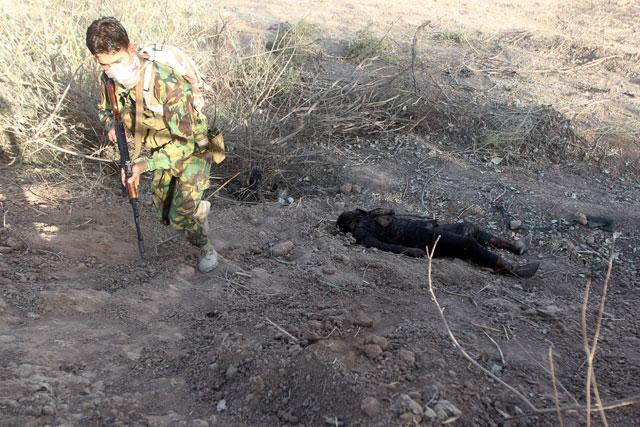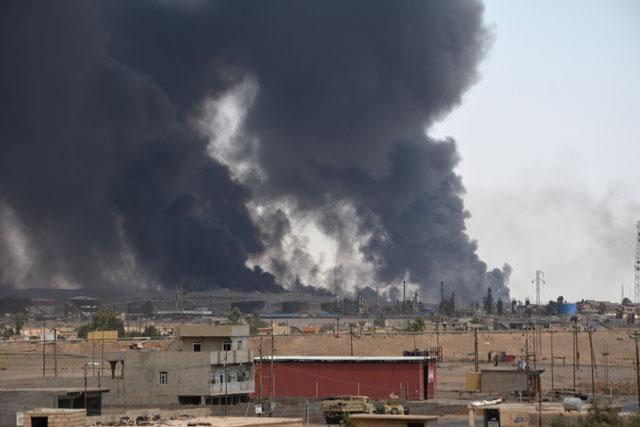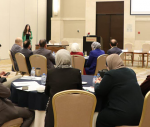You are here
Once promised paradise, Daesh fighters end up in mass graves
By AFP - Oct 17,2017 - Last updated at Oct 17,2017
DHULUIYAH, Iraq — The Daesh terror group once drew recruits from near and far with promises of paradise but now bodies of extremists lie in mass graves or at the mercy of wild dogs as its "caliphate" collapses.
Flies buzz around human remains poking through the dusty earth in the Iraqi town of Dhuluiyah, 90 kilometres north of Baghdad, at a hastily-dug pit containing the bodies of dozens of Daesh fighters killed in 2015.
"They should have ended up in the stomachs of stray dogs," local police officer Mohammed Al Juburi told AFP.
"We buried them here not out of love but because we wanted to avoid diseases."
At one stage, Daesh ruthlessly wielded power over a vast swathe of territory straddling Iraq and Syria, but a military onslaught on multiple fronts has seen its fiefdom shrink to a last few pockets.
Since the launch in 2014 of air strikes in Iraq and Syria against the group, a US-led coalition says around 80,000 extremists have been killed.
The overall number of dead is higher if you include those targeted by Russian and Syrian strikes.
Buried with bulldozers
In agricultural Dhuluiyah on the banks of the Tigris river, residents faced a common dilemma over what to do with the corpses of Daesh fighters after local Sunni militiamen beat back the extremists in fierce clashes.
"We could have thrown them into the water, but we love the river too much to pollute it," said the local policeman, who lost his own brother in the violence.
"The people here as well as their animals drink from the Tigris."
Locals finally decided to dig a mass grave for the fighters — but they said they refused to honour them with Islamic rites.
"We buried them with bulldozers. Even in the ground they are still mired in their own filth," said farmer Shalan Al Juburi.
"They said that they would go to paradise to enjoy the gardens of delights, but this is how they ended up."
The desolate site is in stark contrast to a nearby graveyard surrounded by a red-brick wall a few hundred metres away.
There the "martyrs" who died helping to stop the extremist advance lie in well-tended tombs adorned with their portraits and shaded by trees.
Elsewhere, in western Iraq's Anbar province, the luckiest among the Daesh dead appear to be those killed during its offensives against the army in 2015.
In the centre of Fallujah, the first major city captured by the group in 2014, hundreds of memorials in a makeshift cemetery bear the noms de guerre of foreign fighters buried by their comrades.
But as Iraqi forces in Anbar now look to oust the extremists from their final footholds, operation commander Mahmoud Al Fellahi insisted any extremists killed will end up in mass graves.
A similar fate befell Daesh members in the city of Mosul, the group's largest urban stronghold in Iraq that it lost in July.
There, a senior Iraqi commander told AFP, authorities used earthmoving equipment "to bury the extremists after we collected information on their identities and nationalities".
'Desert dogs
are waiting'
Across the border in Syria — where competing Russian and US-backed offensives are squeezing Daesh — the Britain-based Syrian Observatory for Human Rights estimates some 50,000 Daesh members have been killed.
As clashes rage with the extremists, one Syrian commander said that what happens to dead fighters is not a priority.
"At the moment, we are more interested in what happens above the ground than under it," he told AFP.
Another military source said the identities of the fighters can provide useful intelligence.
"The terrorists try to collect their dead. If we find them, we try to identify the foreigners for a possible information swap with their home countries," the source said.
In the desert plains that the extremists once dominated, the bodies of dead fighters are left abandoned, a pro-regime militia head told AFP.
"The desert dogs are waiting for them," he said. "When the fighting ends, the dogs come out from hiding to look for bodies."
A spokesman for the US-backed force close to ousting Daesh from the city of Raqqa said the bodies of the group's members were "generally buried" whenever possible.
"But sometimes due to snipers or because they are under rubble, some of the bodies end up rotting," said Syrian Defence Forces representative Mustefa Bali.
While the rank-and-file are often left forgotten, Daesh appears to have taken care to hide the final resting places of prominent Western extremists.
"Figures who were well-known and wanted by the international community are buried at secret locations," said the Syrian observatory head Rami Abdel Rahman.
Those include notorious British executioner Mohamed Emwazi, known as "Jihadi John", propaganda chief Abu Muhammad Al Adnani and military leader Omar Al Shishani.
There has been no record of bodies of foreign extremists being repatriated, said Abdel Rahman.
Related Articles
When jihadists from the Islamic State group attacked last week the Shiite village of Al Saud in central Iraq received help from an unlikely source.
BAGHDAD — Iraqi authorities said on Sunday the remains of 123 people killed by the Daesh terror group extremists had been removed from a mas
KIRKUK, Iraq — Iraqi forces on Wednesday closed in on the centre of Qayyarah, officials said, on the second day of an operation to recapture



















